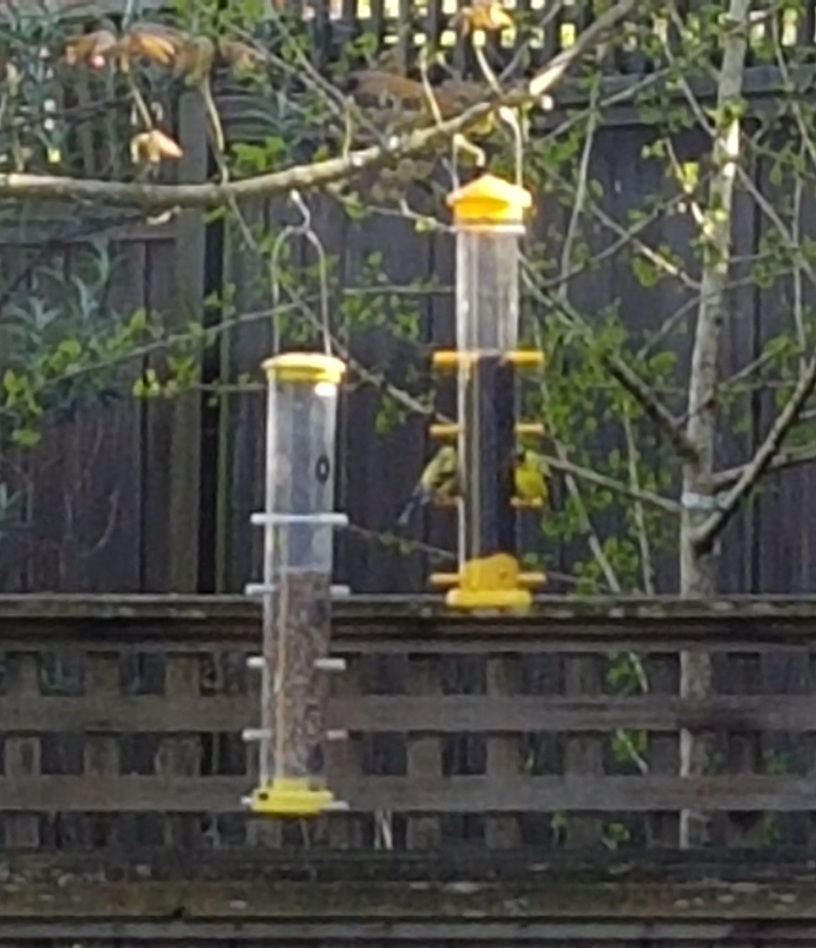My Experience
I am always excited to see the first American goldfinches arriving each year. It is a sign that summer is approaching, especially once the bright yellow breeding plumage appears. For me, this first visit came last weekend, though it was snowing so did not feel particularly summery. Since there was snow on the ground, I am assuming that the finches only came to my feeders because their other food sources had been covered so will remain scarce until mid-March when the real signs of spring are kicking in and they need to change into their summer colours. However, I am going to remain positive as there are buds appearing on the trees and I need a hope that spring break will come soon! Goldfinches also migrate and are only in British Columbia during breeding season so the fact that they are here at all is a sign of approaching warmth.
Goldfinches are all in uniform with the other birds of their species and gender. However, there is one bird that I have gotten to know this past winter which looks remarkably different from the rest of its flock. I do not know whether it is a malfunction in changing plumage or some sort of random gene mutation but this bird has maintained a bright yellow cap throughout the winter. It is very noticeable to have a spot of canary within all of dark winter feathers huddling around the seed feeder so I always smile whenever I see my unique new friend at the feeder. I can only hope that they look the same next winter. Perhaps this goldfinch will even look different during the summer if it is female with a bright yellow cap or male without the iconic black cap.
Attracting
During the spring, most gardens with feeders in the correct region (southern British Columbia) will receive enough American goldfinches to make missing them impossible. They will swarm onto a garden’s feeders, eat all of the seed within a couple of days, and then move on until the feeders have been refilled. Of course the swarming is an exaggeration but for a few weeks during early spring, it is true that the goldfinches consume supplies almost faster than they can be restocked.
They take all of this food to maintain their energy while changing plumage, both to summer and to winter colours. As with species such as the Anna’s hummingbird, it is possible that goldfinches have begun to rely on on feeders as far north as Canada during this period of moulting. This is why it important to keep restocking the feeders even if it means doing it twice or more each week. I did a science project in grade eight that tested what type of seed garden birds preferred out of niger or mixed. It was found that dark-eyed juncos generally stuck with the mixed seeds but while the American goldfinches were here, they would almost always drain the niger feeder before starting on the mixed. Either way they should stick around as long as there is a seed feeder of some sort in your garden during spring or autumn.
Fun Facts
- American goldfinches are strict vegetarians, which is surprisingly uncommon in the bird world. While goldfinches will eat bugs if their options are limited, they prefer to stick with seeds and will even feed seeds to the young even though many bird species switch because insects are so much more filling and nutritional. This diet contributes to goldfinches breeding in late July or August rather than the usual early spring because they wait for the most seeds to be around.
- Perhaps not such a fun fact but important nonetheless is that American goldfinches are prone to catching eye disease. This is a disease that blinds and weakens finches and was first noticed in house finches thanks to citizen scientists but has now adapted and spread to many other bird species though it only shows up in finches. For extra reading on its history and what can be done about it, Feederwatch and Cornell Lab both have some interesting articles, not only including the ones I added links to.
Similar Species
- The easiest bird to confuse with the American goldfinch is the pine siskin during the winter. Both are a dull brown during these months and have similar seed diets and flocking habits. My trick for telling them apart is by looking closely with binoculars at the plumage and determining whether the bird is fully one colour or slightly darker with dark streaks across the breast. Goldfinches are the lighter birds of fully one colour. They also have a distinctive black and white portion of the wing while siskins have wings with a tinge of yellow.
Picture
This picture was taken during the spring a couple of years ago. The two American goldfinches in the photo are eating niger seed and only recently changed into their breeding plumage.
